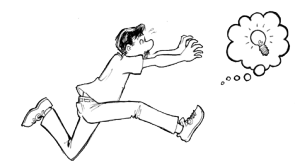Six Common Mistakes made by Webcartoonists
You don’t need a subscription to read today’s post!
This is a re-post from the Webcomics.com archive. If you’ve ever been curious about the kind of information, tutorials and advice that you’ll get as part of your subscription to Webcomics.com, this is a good example.
If you’d like to join the site, you can get a 12-month subscription for $30 — or you can get a one-month Trial for $5 … with no obligation after your 30 days expire. For less than three bucks a month, you can get a steady flow of information, tutorials and advice targeted towards your webcomic business — plus a private forum to discuss issues with other professionally minded cartoonists.
I’ve been writing for this site since 2009, and I see a lot of webcomics. I initiate critiques, I get asked to do portfolio reviews at conventions, and I do comic consulting. I do it because I like it. I love talking comics, and I like having the opportunity to pass along the things I’ve learned by doing this for so long. AND, as I often say — here and to my classes at Hussian School of Art — I’ve already made all the mistakes so you don’t have to.
In seeing all of those webcomics, I see a lot of the same mistakes pop up over and over again. So I want to isolate the top five — not in a “boy are you a loser” way. Rather, since many of these are so widespread, my hope is that we can take some big steps to eradicating these six.
Number one should be no big surprise…

CC BY-ND Brandi Redd
Lettering
I’ve said it before, and I’ll say it again. If you improve your lettering tonight, your readers will perceive you as 100% more professional tomorrow. There’s a lot of good information about lettering — both hand-lettering and digital — on this site. It’s worth your time to read through as many of those posts as you can. But here’s some bullet points:
• Don’t let your words touch the lines of the word balloon. Ever.
• Keep an equal margin inside the word balloon (between the text and the lines) — all the way around. If you have more space at the top and bottom than you have on the sides, your balloons will feel awkward.
• When word balloons get huge, chop them into smaller balloons.
• Never, ever cross word-balloon tails. Ever.
• The words inside balloons should look like units — not as separate lines of text. If they look like separate lines, tighten up that leading (the space between lines of type). This Hot Seat critique of House of Madness does a good job of explaining this.
• Don’t use Comic Sans. It’s not a very graceful lettering font. And, seriously, with the number of affordable (if not downright free) comic-lettering fonts on sites like Blambot.com and Comicraft.com, there’s just no excuse.
• Word balloons that span the width of a panel — especially if they’re only one or two lines of type — look awkward. Use them sparingly.
• If you use a funky font to denote an alien voice or an ancient text, that’s fine. As long as it’s legible. It may look exactly like Renaissance script, but if I can’t read it, it may as well be gibberish. Same goes for the old “use a weird voice for the alien/robot/’other’ character.” Try this instead — challenge yourself to describe that character’s “otherness” in the words and phrases the character chooses. It’s waaaaay more powerful than a funky font.
• If you’re hand-lettering use an Ames Lettering Guide. It’s cheap, it’s easy, and it’s indispensable.
Writing
 Write it. Put it away. Come back to it later. Re-write it.
Write it. Put it away. Come back to it later. Re-write it.
Nothing is very good in its first draft. That’s why they’re called first drafts. If you’re not re-writing your material, chances are, you’re posting stuff that’s not very good. When you’re re-writing, look for stuff like…
• Spelling and grammar mistakes. I’ll point it out before anyone decides to “out” me. I’m as guilty on this one as anyone else. It doesn’t mean you can ignore this tip, though. It just means I need to pay attention to it just as badly as some of you do!
• Edit, edit, edit. This is comics, people. It’s all about quick, rewarding entertainment. If you can say it in fewer words, you will — nine chances out of ten — improve the reader’s experience. Usually that’s because saying it in fewer words means making better, more descriptive word choices. And that’s Good Writing.
• Remember the visual! We cartoonists have a secret storytelling weapon. We’re presenting images along with out words. Let the two word together. And if the visual is doing its job, get the words out of the way. In other words: show, don’t tell.
• For those of you doing humor: Don’t step on your punchline. Decide where the funniest part in the comic is, and after that — stop! If you write something after the punchline — and it’s not as funny or funnier than the punchline — you just ruined your joke.
Web design
 With WordPress theme/plugin combos such as ComicsPress and Comic Easel, this stuff should be easy, but it’s not always.
With WordPress theme/plugin combos such as ComicsPress and Comic Easel, this stuff should be easy, but it’s not always.
• First screen appeal. We’ve discussed it a lot. Basically, it’s like this. First-timers aren’t likely to scroll down. And if you need to scroll down to read a comic, it’s going to have an adverse effect on how long someone is going to read through your archive. You need to get as much of your site onto the reader’s first-screen view as possible. And that means…
• Ditch that huge header graphic. I’ll be honest with you, the sites I think work the best have a logo to the left of a leaderboard ad across the top of the site. And, really, I don’t know that a comic needs much more than that for branding. After all, the comic itself is going to carry a lot of that responsibility.
• Put the navigation buttons as close as possible to the comic itself. Personally, I like to see them snug underneath the comic. I also prefer standardized arrows over text (a deficiency I keep meaning to address in my own site).
• The About page. Man, you’re missing out on an excellent opportunity to cement a possible new read if you don’t have this.
Social Media
 Yup, it’s part of webcomics. It’s a big part of how marketing and promotion are done. Not comfortable? Get comfortable.
Yup, it’s part of webcomics. It’s a big part of how marketing and promotion are done. Not comfortable? Get comfortable.
Here’s the irony: It takes almost zero writing skill. People aren’t looking for the Great American Novel at 140 characters at a time. They want to know about you. What you’re thinking about. What you’re doing. How you feel about that. It doesn’t have to be deep or inspirational or funny — but those kinds of posts are extremely powerful when they come along. But 85% of it is simply sharing your life in bits and pieces.
Cargo cult
We discussed this in an Archive Dive last month. It’s definitely worth a read if you haven’t yet. In short, cargo-cult mentality involves mimicking the actions of successful people — without understanding why those people are doing what they do. If you’re planning your first T-shirt run before you’ve built a sizable audience with your comic, you might be someone who could fall into this category.
If you’re just starting out, you should be concentrating on making an awesome comic — and then doing it with frequency and consistency. Only after you’ve mastered that should you allow yourself diversions such as merchandise.
Every day is a standalone day
Hands down, this is the single most important concept to understand for webcartoonists. Nothing is as important as this.
Every day a certain number of people come to your site for the very first time. And they make their decision on whether they will read the comic based on the comic that is posted on that site on that day.
If that comic doesn’t…
• Make sense
• Have importance
• Make an impression
…those readers will leave. And they won’t come back.
“Hey, but what about my archive?”
Have you ever gotten into a disappointing experience and then felt the overwhelming urge to extend that experience?
Neither have I.
Neither will your readers.
They’ll only read your archive if today’s comic intrigues them into doing so.
If you’re doing a longform comic, that may mean that you have to rethink your publishing approach.
If you’re doing a strip, that means every day has to be fantastic. (Or as close to fantastic as you can possibly get.)
If you’re posting something that relies on knowledge of one (or worse — several) days of archived backstory, you will lose that first-time reader on that day.
And if you consistently miss the opportunities to convert those first-time readers, your site will fail to grow — and, potentially, wilt and eventually die.




Recent comments